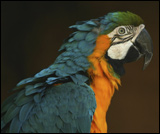Teaching a Pet Parrot Basic Etiquette

Normally, when people buy a pet, they expect it to be able to perform basic tricks and be as obedient as a dog. Now for parrots, the demands may be even higher especially when we see parrots like African Greys exhibiting exemplary skills such as talking, performing tricks and demonstrating their ability to learn basic intellectual games. But what if you are dealing with a parrot that has behavioral problems?
Understanding Parrot Behavior
To learn more on how to effectively train a pet parrot, you need to learn why they are behaving the way they do. For pet dogs, training couldn’t be easier. Dogs normally consider you as their master since they see you as their pack leader. Parrots on the other hand demand that they be treated as your equals. Why? In the wild, they do not designate a single parrot as their pack leader; hence, they are inclined to doing anything they want to do.
Wild parrots have the tendency to form very strong bonds with their mates. They are monogamous creatures and will only find another partner if their current partner fails to produce an offspring (which is considered a very rare occasion) or dies. For pet parrots, their human companions can also be considered as their mates. This generally makes them subject to being jealous when another pet bird is welcomed into the house. Your parrot often sees you as its true love and the new bird is a threat to your relationship.
Ways to Train A Wild Parrot
The following tips will help you train your parrot;
Tip #1: Getting it Acquainted with its Cage for the First Time
If you were able to buy a pet parrot that has been taught how to ‘”step-up”, then you are lucky. Getting it into the cage should be as easy as pie. But this is not always the case. Some parrots being sold are either aggressive or have not been trained at all. If what you have is the latter, what you can do is (gently) grab the parrot with bare hands, ideally at the neck, and help it get into its cage. Remember to do this carefully so as not to cause shock from the experience. Once the parrot is already in its cage, give it some alone time for it to get used to its new home.
Tip #2: Know its Favorite Treat
Training a parrot will require bribing it somehow to get it to do what you want. Thus you will need some treats. How to determine this? Place several treats in its feeding bowl. His favorite will usually get eaten first. You will need to do this for several days to be accurate. You see, your pet parrot may still be getting used to the taste of the treats being offered and still in the process of selecting which of these is its favorite.
Tip #3: Getting Accustomed to Being Touched
In order to be able to teach your pet parrot, you should also be able to hold it with your hands. The first thing that you should try touching is its beak. This is its defensive weapon. If you can get through it, then you should not have any problems touching its other body areas. Hold your hand in front of its beak. If it tries to bite you, then this is an indication that it’s not yet comfortable enough to being touched by you. Doing this repeatedly will eventually reap some results. Offer its favorite treat every time it allows you to touch it. Over time, it will let you touch it even without the aid of treats.
Tip #4: Training Outside the Cage
For parrots, the birdcage is its personal space. This is the main reason why training a parrot in its cage could be ineffective. If you want to succeed in training your pet parrot, you need to do it outside of the cage. A perch, chair, or table are ideal places. Remove unwanted distractions such as toys if you want your parrot’s full attention during training sessions.
Tip #5: Talking is Not for Everyone
Pet parrots talking is a common expectation. But take note that your pet may not be able to acquire this talent. Males are more likely to talk than female parrots. To increase their chances of mouthing some words, expose it to speech or purposefully repeat words or phrases that you want it to learn. If you want it to learn more than simple mimicking and actually be able to correctly associate the word with a certain thing or event, you can do this too. For example, say “nut” when feeding it with this food or “hello” only upon entering the room.
Tip #6: Foraging Helps Improve Parrot Behavior
Wild birds forage in their natural habitat. It’s one of their recreational activities that keep them from getting bored. Parrots getting bored are never a good thing. It is one of the reasons why they pluck their feathers. Foraging inside the room will help prevent this problem. Furthermore, foraging for toys will also keep parrots distracted from over vocalizing when their favorite person is leaving the room.
Additional Safety Reminders
When handling a wild parrot for the first time, you may need to use some protective gear such as gloves or goggles to protect yourself from being hurt. For your pet parrot’s safety, take out possible hazards in the house when it is foraging. Examples of these are wires (they could get caught in these) and choking hazards such as buttons.
Article by Jordan Walker
